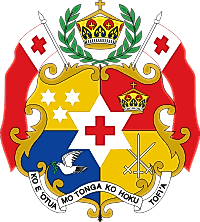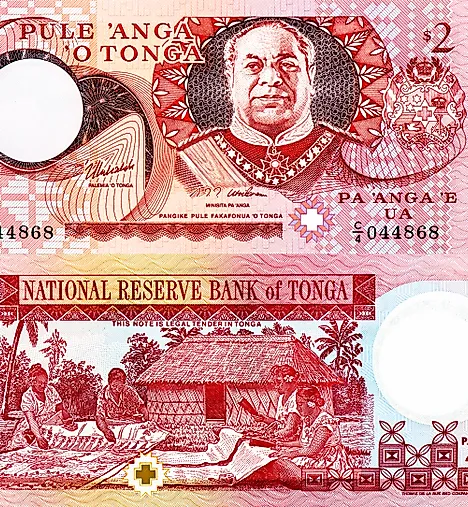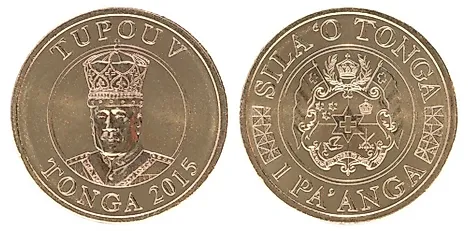Flags, Symbols & Currency of Tonga

The National Flag of Tonga was officially adopted on November 4, 1875.
The National Flag of Tonga features a red background with a bold Greek red cross on a white rectangle in the upper hoist-side corner. The red color represents religion and the sacrifice of the Blood of Christ, which was shed during his Crucifixion. The white color symbolizes purity. The cross reflects Christianity - the predominant religion in Tonga that is practiced by nearly 97% of the Tongans. The flag has a width-to-length proportion ratio of 1:2.
History of the Flag of Tonga
British explorer Captain James Cook had thrice visited the islands between 1773 and 1777, and Tonga gradually becomes influenced by the British. About 50 years later, Christian missionaries began converting Tongans to Christianity. In 1831, the leader or paramount chief of the islands also became a Christian and was named King George Tupou I in 1845. The first national flag of Tonga was adopted sometime during this time under the reign of King George Tupou I. This flag featured a white field with a red or blue cross in each of the four corners. Additionally, the letters "A" and "M" in red and blue, respectively, were included in the center of the flag, which symbolized the king. However, this flag was only used briefly. The king soon sought the help of British missionary Shirley Waldemar Baker to help design a new national flag. The king wanted a flag that would represent Christianity, and the new flag was similar to the British Red Ensign. Three-quarters of the flag was red, while the upper corner of the hoist-side of the flag featured a distinctive canton. This flag was first used in 1866. Tonga's current flag was adopted on November 4, 1875, and according to Article 47 of the country’s Constitution, this flag can never be altered ever. The Flag of tonga is one of the oldest flags of the island countries in the South Pacific Ocean.
Symbols of Tonga
The National Coat of Arms of Tonga

The National Coat of Arms of Tonga was adopted in 1875 and features a large shield divided into four quarters. The Royal Crown of Tonga is displayed in the top-right quadrant, the top-left contains three stars, the bottom-left a dove holding an olive branch, and in the bottom-right are three crossed swords. Each of these symbolizes an important element for Tonga: the dove and olive branch are for the wish of God's peace (taken from the story of Noah and the Great Flood), the three stars represent the main island groups of Tonga, the crown is for the ruling monarchy, and the swords represent the three dynasties of the kings (Tuʻi Tonga, Tuʻi Haʻatakalaua and the current Tuʻi Kanokupolu). Below the shield, Tonga's motto "Ko e ʻOtua mo Tonga ko hoku Tofiʻa" ("God and Tonga are my inheritance") is displayed on a ribbon, and making up the crest is the Royal Crown of Tonga supported by olive branches.
National Motto
"Ko e ʻOtua mo Tonga ko hoku Tofiʻa" ("God and Tonga are my inheritance")
National Anthem
- Anthem Title: "Ko e fasi ʻo e tuʻi ʻo e ʻOtu Tonga" ("Song of the King of the Tongan Islands")
- Music Composer: Karl Gustavus Schmitt.
- Lyricist: Prince Uelingatoni Ngu Tupoumalohi
- Date of Adoption: 1874
"Ko e fasi ʻo e tuʻi ʻo e ʻOtu Tonga" ("Song of the King of the Tongan Islands") is the national anthem of Tonga. The music of the anthem have been composed by Karl Gustavus Schmitt. The lyrics of the anthem have been authored by Prince Uelingatoni Ngu Tupoumalohi. The anthem was officially adopted as the national anthem in 1874.
"Ko e fasi ʻo e tuʻi ʻo e ʻOtu Tonga" (Tongan)
ʻE ʻotua māfimafi
Ko homau ʻeiki koe
Ko koe ko e falalaʻanga
Mo e 'ofa ki Tonga;
ʻAfio hifo ʻemau lotu
ʻA ia ʻoku mau faí ni
Mo ke tali homau loto
ʻO maluʻi ʻa Tupou.
"Song of the King of the Tongan Islands"
Oh, almighty God!
You are our Lord,
It is You, the pillar
And the love to Tonga.
Look down on our prayer
That is what we do now
And may You answer our wish
To protect Tupou.
The Currency of Tonga is the Tongan pa’anga
The current official currency of Tonga is Tongan pa’anga (TOP, T$). The pa'anga is subdivided into units called seniti. The National Reserve Bank of Tonga is responsible for promoting financial stability in the country, and mints and distributes the Tongan pa’anga. What is unique about the currency is that it is usually pegged to various world currencies including the Australian, New Zealand, and US dollars, and the Japanese yen.
Coins
Currently, coins in denominations of 1, 2, 5, 10, 20, and 50 seniti and T$1 are in circulation, with the 1 and 2 senitis losing their value and are therefore no longer used.
The first coins were issued in 1967 in denominations of 1, 2, 5, 10, 20, and 50 senitis, as well as 1 and 2 pa’anga, which were made of copper and cupro-nickel, respectively. The newest issue of the coins, done in 2015, now features the portrait of a king, replacing the previous theme revolving around food and agriculture production. The new coins issued during this time were minted by the Royal Australian Mint.
Banknotes
Currently, banknotes in denominations of T$1, T$2, T$5, T$10, T$20, T$50, T$100 are in circulation.
In 1967, Tongan banknotes were introduced in denominations ½, 1, 2, 5, and 10 pa’anga, and included the portrait of Queen Salote Tupou III. In 1985, notes of 20 and 50 pa’anga were introduced. In 1992, the National Reserve Bank of Tonga was granted the mandate of issuing money introducing a new series of banknotes in 2008. The notes are printed in Tongan language and bear the portrait of the emperor on the obverse, while the reverse is printed in English, with distinctive landmarks of Tonga, including the Haʻamongaʻa Maui Trilithon, burial mounds, and school going students, the royal palace, a humpback whale, the Tongan Development Bank, rugby players and the Port Vavaʻu. The latest issue of the Tongan pa’anga was done in 2015 in denominations ranging from 2 to 100 pa’anga, and bears the portrait of Tupou VI, the current king of Tonga.
Historical currencies of Tonga
The word pa’anga is a native term that refers to a bean-like vine bearing large pods with reddish-brown seeds. The seeds were incorporated into dancing costumes for the kailao dance as well as acting as playing stones. In 1806, Tongans attacked a Port-au-Prince ship that was full of round pieces of metal, which were meant to act as money. However, the official introduction of the Tongan Pa’anga was on April 3, 1967, when they were introduced to replace the Tongan pound at the rate of 1 pound for 2 pa’anga.















